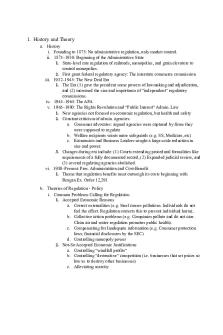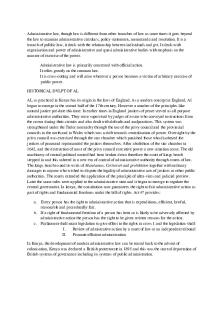G. M. Wagh - Administrative Law - RLLC (2003 ) PDF

| Title | G. M. Wagh - Administrative Law - RLLC (2003 ) |
|---|---|
| Author | Catherine Preethi |
| Course | Administrative law |
| Institution | Karnataka State Law University |
| Pages | 182 |
| File Size | 2.3 MB |
| File Type | |
| Total Downloads | 654 |
| Total Views | 811 |
Summary
ADMINISTRATIVE LAWG. M. WAGH20034 Administrative Law - Exclusion of Courts’ Jurisdiction........................................................ - Financial Levy..................................................................................... - Explanatory Notes.....................................
Description
ADMINISTRATIVE LAW
G. M. WAGH
2003
TABLE OF CONTENTS Table of Contents.................................................................................3 1. Introduction....................................................................................9 Definition of Administrative Law.............................................................10 Sir Ivor Jennings’ Definition................................................................10 Dicey’s Definition................................................................................11 Kenneth Culp Davis’s Definition.........................................................11 Nature and Scope of Administrative Law.................................................13 Reasons for Growth of Administrative Law..............................................14 Constitutional Law vs. Administrative Law.............................................15 Difference Between Constitutional Law and Administrative Law.........16 Droit Administratif in France...................................................................17 Montesquieu’s Doctrine of Separation of Powers.....................................19 Rule of Law.............................................................................................21 Application of the Doctrine in England................................................21 Rule of Law under the Constitution of India........................................22 2. Delegated Legislation.....................................................................23 Introduction...........................................................................................24 Need for Delegated Legislation................................................................24 Constitutional Validity of Delegated Legislation......................................25 Essential Legislative Function................................................................27 Types of Delegated Legislation................................................................29 Control of Delegated Legislation..............................................................34 1. Judicial Control..............................................................................34 Attempts to Exclude Judicial Review...............................................39 2. Legislative Control..........................................................................43 3. Procedural Control..........................................................................46 Effect of Rules Being Ultra Vires..............................................................49 Other Aspects of Delegated Legislation...................................................49 Retrospective Operation of Delegated Legislation................................49 Retrospective Rules under art. 309 of the Constitution...................50
(iii)
4
Administrative Law Exclusion of Courts’ Jurisdiction........................................................50 Financial Levy.....................................................................................50 Explanatory Notes...............................................................................51 Delay in Making Rules........................................................................52 Sub-delegation of Legislative Functions..............................................52 Waiver of Rules...................................................................................52 Continuance of Rules After Repeal of Parent Statute...........................53
3. Quasi Legislation...........................................................................54 Introduction...........................................................................................55 Delegated Legislation and Quasi Legislation...........................................55 Delegated Legislation Treated as Quasi Legislation.................................57 Enforceability of Quasi Legislation..........................................................58 Publication of Directions.........................................................................64 4. Natural Justice
65
Introduction...........................................................................................66 Rule Against Bias...................................................................................67 Personal Bias......................................................................................67 Pecuniary Bias....................................................................................69 Bias as to Subject-matter....................................................................69 Departmental Bias..............................................................................70 Pre-conceived Notion Bias...................................................................71 Bias on Account of Obstinacy.............................................................72 Conclusion..........................................................................................72 Right of Fair Hearing..............................................................................73 Components of Fair Hearing...............................................................73 1. Right to Notice............................................................................73 Consequences of Non-issuing of Notice........................................75 2. Right to Appearance....................................................................75 3. Right to Know Adverse Evidence.................................................75 4. Right to Present Case..................................................................75 5. Right to Present Evidence............................................................76 6. Right That Evidence Shall Not Be Collected At His Back.............77 7. Right to Rebut Adverse Evidence.................................................77 (a) Right to Cross Examination....................................................78 (b) Right to Legal Representation (Right to Counsel)....................78
Table of Contents 8. Right to Report of Enquiry...........................................................79 One Who Decides Must Hear.......................................................79 Institutional Hearing...................................................................79 Failure to Supply Copy of Report.................................................79 9. Right to Speaking Order..............................................................82 Implied Constitutional Perspective...............................................82 Implied Statutory Perspective......................................................83 Circumstances Rendering Hearing Unfair...........................................84 Dictation.........................................................................................84 Financial Incapacity to Attend Enquiry...........................................84 Decision Post Haste.........................................................................85 Exceptions to Natural Justice.................................................................85 1. Emergency......................................................................................85 Post Decisional Hearing..................................................................85 2. Confidentiality................................................................................85 3. Ministerial Functions......................................................................86 Academic Matters............................................................................86 4. Impracticability...............................................................................86 5. Interim Preventive Actions..............................................................86 6. Legislative Functions......................................................................86 7. No Infringement of Rights...............................................................86 8. Statutory Exceptions and Necessity................................................86 9. Contractual Matters........................................................................87 10. Policy Matters...............................................................................87 11. Where Hearing is a Useless Formality...........................................87 Right of Third Parties..............................................................................87 Effect of Violation of Natural Justice.......................................................88 5. Administrative Functions...............................................................90 Introduction...........................................................................................91 Classification of Administrative Functions..............................................92 Judicial Review of Discretionary Functions.............................................92 Doctrine of Ultra Vires........................................................................92 Stages.................................................................................................92 At the Stage of Conferment of Powers..................................................93 Conferment of Discretion and Art. 14..............................................93
5
6
Administrative Law Differential Procedure..................................................................93 Conferment of Discretion and Fundamental Freedoms....................94 Art 19(1)(a) Freedom of Speech and Expression...........................94 Art 19(1)(c) Freedom to Form Associations or Unions..................95 Art 19(1)(d) Freedom to Move Freely Throughout the Territory of India ...................................................................................................95 Art 19(1)(e) Freedom to Reside and Settle in Any Part of India.....95 Art 19(1)(f) Freedom to Property...................................................95 Art 19(1)(g) Freedom of Trade and Occupation.............................95 At the Stage of Exercise of Powers.......................................................96 1. Failure to Exercise Discretion......................................................96 1. Acting Mechanically.................................................................96 2. Abdication of Discretion..........................................................97 3. Acting Under Dictation............................................................98 4. Imposing Fetters on Discretion................................................99 5. Exercise at Wrong Time...........................................................99 6. Powers Coupled with Duty.......................................................99 2. Wrong Exercise of Discretion ....................................................100 1. Irrelevant Consideration........................................................100 2. Leaving Out Relevant Consideration......................................101 3. Mixed Consideration..............................................................101 4. Colourable Exercise...............................................................102 5. Use for Collateral Purpose.....................................................102 6. Mala fide Exercise of Power....................................................103 7. Unreasonable Exercise..........................................................104 Wednesbury Unreasonableness.............................................105 8. Lack of Jurisdiction to Exercise.............................................107 9. Exercise in Excess of Jurisdiction..........................................107 10. Non-compliance of Procedural Requirements.......................107 11. Exercise in Violation of Natural Justice...............................107
6. Quasi Judicial Functions..............................................................108 Introduction.........................................................................................109 Characteristics of Quasi-judicial Functions..........................................109 1. Lis Inter Partes...............................................................................109 2. Provision for Administrative Appeal...............................................109 3. Powers of Court............................................................................110
Table of Contents 4. Adverse Civil Consequences..........................................................110 5. Duty to Act Judicially...................................................................110 Distinction between Administrative and Quasi-judicial Functions........111 General.............................................................................................111 Object...............................................................................................111 Lis.....................................................................................................111 Duty to Act Judicially.......................................................................112 Duty to Act Fairly..............................................................................113 Cases................................................................................................113 Test...................................................................................................114 Judicial Functions and Quasi Judicial Functions.................................114 Judicial Functions............................................................................114 Quasi Judicial Functions..................................................................115 Distinction between Judicial and Quasi-Judicial Functions..............116 Need for Quasi Judicial Functions........................................................117 1. Burden on Courts Resulting in Delay............................................117 2. Specialisation...............................................................................117 3. Informality....................................................................................117 4. Inexpensive...................................................................................118 5. Preventive Rather than Remedial..................................................118 6. Policy May Be Applied (Functional Approach)................................118 7. General Rather than Special Treatment to Cases..........................118 Advantages of Quasi-judicial Decision-making.....................................118 1. Socialisation of Law......................................................................118 2. Informal, Inexpensive and Quick Remedy.....................................118 3. Preventive Action, Rather than Curative........................................118 4. Functional Approach....................................................................118 5. Experience....................................................................................119 Problems Related to Quasi-judicial Functions.......................................119 1. Number and Complexity...............................................................119 2. Varieties of Procedures..................................................................119 3. Unsystematic System of Appeals...................................................119 4. Invisibility of Decisions.................................................................119 5. Unpredictability of Decisions........................................................119 6. Anonymity of Decisions.................................................................119 7. Combination of Functions.............................................................119
7
8
Administrative Law 8. ‘No Evidence’ rule.........................................................................120 9. Official Perspective........................................................................120 10. Official Bias................................................................................120 11. Plea Bargaining...........................................................................120 12. Political Interference...................................................................120 13. Off the Record Consultation........................................................120 14. Reasoned Decision......................................................................120 15. Legal representation....................................................................120 Enquiry Against Quasi-judicial Authorities...........................................121 Administrative Tribunals......................................................................121 Constitutional Validity of Administrative Tribunals Act, 1985...........121
7. State Liability..............................................................................123 Liability of State under Constitution.....................................................124 Contractual Liability.............................................................................124 Expressed to be Made by the President/Governor.............................125 Executed on Behalf of the President/Governor..................................126 By Person Authorized the President/Governor..................................126 Tortuous liability..................................................................................127 Pre Constitutional Decisions.............................................................128 Post Constitutional Decisions...........................................................129 Constitutional Torts......................................................................131 Sovereign and Non-sovereign Functions Distinguished.................131 Analysis of Judgement in Nagendra Rao Case...............................132 8. Judicial Review............................................................................133 Introduction.........................................................................................134 Judicial Review and Appeal...............................................................134 Doctrine of Legitimate Expectation....................................................134 Doctrine of Public Accountability......................................................137 Doctrine of Proportionality................................................................139 Procedural Aspects...............................................................................140 Doctrine of Standing.........................................................................140 Locus Standi .................................................................................140 Exceptions to the Rule of Locus Standi..........................................141 Class Actions................................................................................141 Public Interest Litigation...............................................................141
Table of Contents Doctrine of Res Judicata....................................................................143 Jurisdiction......................................................................................145 Jurisdiction of Supreme Court under arts. 32 and 136.................145 Jurisdiction of High Courts under arts. 226 and 227....................146 Violation of Procedural Norms...........................................................146 Grounds of Judicial Review..................................................................146 1. Illegality........................................................................................147 2. Irrationality and Unreasonableness..............................................147 3. Procedural Impropriety.................................................................148 Writs....................................................................................................148 1. Habeas Corpus.............................................................................150 2. Writ of Mandamus..................................
Similar Free PDFs

Administrative Law - Admin Law
- 6 Pages

Administrative Law Outline
- 33 Pages

Administrative Law - Essay
- 5 Pages

Administrative law (4th)
- 59 Pages

Administrative Law Outline / Summary
- 46 Pages

Administrative LAW MERITS REVIEW
- 38 Pages

Administrative Law Outline
- 14 Pages

Administrative Law 70617 - Essay
- 14 Pages

Administrative law Notes Kenya
- 10 Pages

Canadian Administrative Law
- 54 Pages

Administrative LAW I Notes
- 90 Pages

Administrative Law Summary Notes
- 90 Pages

Administrative Law notes
- 32 Pages

Administrative LAW (notes)
- 92 Pages

Administrative law notes
- 36 Pages
Popular Institutions
- Tinajero National High School - Annex
- Politeknik Caltex Riau
- Yokohama City University
- SGT University
- University of Al-Qadisiyah
- Divine Word College of Vigan
- Techniek College Rotterdam
- Universidade de Santiago
- Universiti Teknologi MARA Cawangan Johor Kampus Pasir Gudang
- Poltekkes Kemenkes Yogyakarta
- Baguio City National High School
- Colegio san marcos
- preparatoria uno
- Centro de Bachillerato Tecnológico Industrial y de Servicios No. 107
- Dalian Maritime University
- Quang Trung Secondary School
- Colegio Tecnológico en Informática
- Corporación Regional de Educación Superior
- Grupo CEDVA
- Dar Al Uloom University
- Centro de Estudios Preuniversitarios de la Universidad Nacional de Ingeniería
- 上智大学
- Aakash International School, Nuna Majara
- San Felipe Neri Catholic School
- Kang Chiao International School - New Taipei City
- Misamis Occidental National High School
- Institución Educativa Escuela Normal Juan Ladrilleros
- Kolehiyo ng Pantukan
- Batanes State College
- Instituto Continental
- Sekolah Menengah Kejuruan Kesehatan Kaltara (Tarakan)
- Colegio de La Inmaculada Concepcion - Cebu
